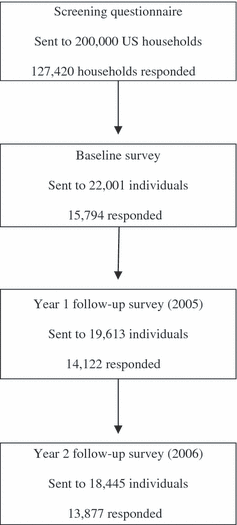Self-reported diagnosis of heart disease: results from the SHIELD study
- PMID: 19392922
- PMCID: PMC3002042
- DOI: 10.1111/j.1742-1241.2009.02049.x
Self-reported diagnosis of heart disease: results from the SHIELD study
Abstract
Objective: This study evaluated the self-reported method of diagnosis of heart disease (HD) to elucidate whether diagnosis is occurring at early, presymptomatic stages as recommended by the prevention guidelines.
Methods: Respondents to the 2006 survey in the US population-based Study to Help Improve Early evaluation and management of risk factors Leading to Diabetes (SHIELD) reported whether a physician told them that they had HD, including heart attack, angina, heart failure, angioplasty or heart bypass surgery. Self-report of age at diagnosis, specialty of physician who made the diagnosis and whether the diagnosis was made after having symptoms, during routine screening or while being treated for another health problem were assessed. Year of diagnosis was categorised into 3-year intervals from 1985 to 2006. Individuals with HD diagnosis with and without type 2 diabetes mellitus (T2DM) were compared using chi-square tests.
Results: Of 1573 respondents reporting a diagnosis of HD, > 87% were white, > 49% were men and 38% had T2DM. Approximately 19% of respondents reported that their HD diagnosis was made during routine screening. A significantly greater percentage of HD respondents with T2DM reported the diagnosis being made based on symptoms (54%) and while being treated for another health problem (22%) compared with respondents without diabetes (48% symptoms and 15% other health problem, p > 0.05). HD was diagnosed primarily by cardiologists (> 60%) and family doctors (> 25%).
Conclusion: There remains a missed opportunity to diagnose HD at earlier stages through routine screening or during treatment of other health conditions such as diabetes, as many individuals were not diagnosed until they were symptomatic.
Figures



Similar articles
-
Trends in Method of Diagnosis of Type 2 Diabetes Mellitus: Results from SHIELD.Int J Endocrinol. 2009;2009:796206. doi: 10.1155/2009/796206. Int J Endocrinol. 2009. PMID: 20011059 Free PMC article.
-
Prevalence of self-reported diagnosis of diabetes mellitus and associated risk factors in a national survey in the US population: SHIELD (Study to Help Improve Early evaluation and management of risk factors Leading to Diabetes).BMC Public Health. 2007 Oct 3;7:277. doi: 10.1186/1471-2458-7-277. BMC Public Health. 2007. PMID: 17915014 Free PMC article.
-
Cohort comparison study of cardiac disease and atherosclerotic burden in type 2 diabetic adults using whole body cardiovascular magnetic resonance imaging.Cardiovasc Diabetol. 2015 Sep 18;14:122. doi: 10.1186/s12933-015-0284-2. Cardiovasc Diabetol. 2015. PMID: 26382729 Free PMC article.
-
Macrovascular Complications of Type 2 Diabetes Mellitus.Curr Vasc Pharmacol. 2020;18(2):110-116. doi: 10.2174/1570161117666190405165151. Curr Vasc Pharmacol. 2020. PMID: 30961498 Review.
-
Microvascular Complications of Type 2 Diabetes Mellitus.Curr Vasc Pharmacol. 2020;18(2):117-124. doi: 10.2174/1570161117666190502103733. Curr Vasc Pharmacol. 2020. PMID: 31057114 Review.
Cited by
-
The changeable dynamics between glycaemic control and neuropathy risk across the lifespan of Saudi diabetic patients; A survey in diabetes healthcare facility.J Family Med Prim Care. 2022 May;11(5):1745-1747. doi: 10.4103/jfmpc.jfmpc_1362_21. Epub 2022 May 14. J Family Med Prim Care. 2022. PMID: 35800515 Free PMC article.
References
-
- American Heart Association . Heart Disease and Stroke Statistics – 2007 Update. Dallas, TX: American Heart Association; 2007.
-
- American Heart Association . Heart and Stroke Facts. Dallas, TX: American Heart Association; 2003.
-
- Grundy SM, Balady GJ, Criqui MH, et al. Primary prevention of coronary heart disease: guidance from Framingham: a statement for healthcare professionals from the AHA Task Force on Risk Reduction. American Heart Association. Circulation. 1998;97:1876–87. - PubMed
-
- Buse JB, Ginsberg HN, Bakris GL, et al. Primary prevention of cardiovascular diseases in people with diabetes mellitus: a scientific statement from the American Heart Association and the American Diabetes Association. Circulation. 2007;115:114–26. - PubMed
-
- Pearson TA, Blair SN, Daniels SR, et al. AHA Guidelines for Primary Prevention of Cardiovascular Disease and Stroke: 2002 Update: Consensus Panel Guide to comprehensive risk reduction for adult patients without coronary or other atherosclerotic vascular diseases. American Heart Association Science Advisory and Coordinating Committee. Circulation. 2002;106:388–91. - PubMed
Publication types
MeSH terms
LinkOut - more resources
Full Text Sources
Medical

